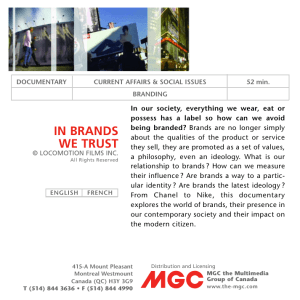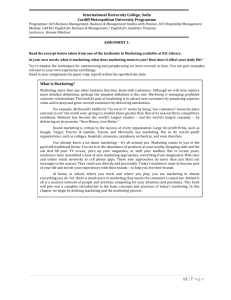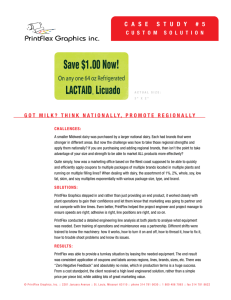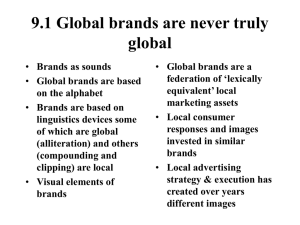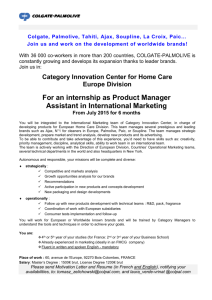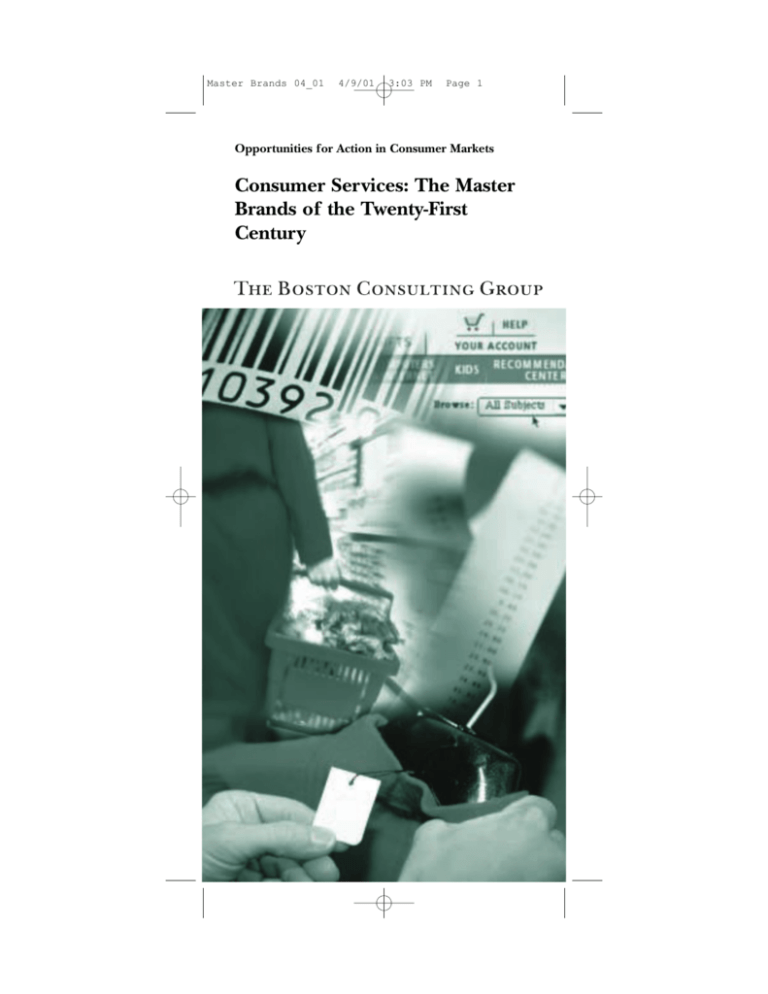
Master Brands 04_01
4/9/01
3:03 PM
Page 1
Opportunities for Action in Consumer Markets
Consumer Services: The Master
Brands of the Twenty-First
Century
Master Brands 04_01
4/9/01
3:03 PM
Page 2
Consumer Services: The Master
Brands of the Twenty-First Century
For many years, consumer service brands were considered the poor cousins of product brands. Services
were often undifferentiated and claimed little brand
equity in consumers’ minds. Choosing a brand meant
deciding between Huggies and Pampers, Folgers and
Maxwell House. Packaged-goods brands ruled.
No longer. Today the most exciting stories in branding are coming out of the service sector. Almost all
new blockbuster brands, like Dell and Starbucks, are
primarily service oriented. E-commerce is creating
instant service brands such as eBay, Amazon, and
Yahoo! And the service environment in which we
shop has itself become a brand: before we choose a
brand of diapers or coffee, we decide whether to
make those purchases at a Tesco supermarket, a
Carrefour hypermarket, or a Wal-Mart supercenter.
Service brands are also starting to go global. Witness
the recent cross-border growth of Carrefour and WalMart, consumer banks Citibank and HSBC, and mobile phone companies Vodafone and Orange.
The enthusiasm for service brands has shown up in
other ways as well. Over the past ten years, the market
capitalization of consumer service companies in the
United States has grown considerably faster than that
of consumer product and retail companies. And
spending on advertising for service brands has increased at a rate that is more than five times higher
than that for product brands. (See Exhibits 1 and 2.)
The rise of service brands presents new challenges for
providers of services and products alike. Service providers face mounting competition as a result of dereg-
Master Brands 04_01
4/9/01
3:03 PM
Page 3
ulation, e-commerce, and globalization—not to mention growing pressure from shareholders to deliver on
the sector’s increasing valuation. For their part, product marketers are under intense pressure from assertive service providers, who are using their strength to
demand large concessions for retail support or for
placement in the service environment. As a result,
some product marketers are beginning to experiment
by offering services over the Internet to reach consumers directly.
Given this increasing competition, all marketers need
to pay close attention to what the best service companies are doing today. In essence, these companies are
creating master brands—trusted names that signify a
rewarding experience and can extend across many
consumer categories. Their recent success offers important lessons in capturing the inherent advantages
of service brands.
Exhibit 1. The Market Value of U.S. ConsumerService Companies Has Soared
CAGR
(%)
Index = 100
800
700
600
Service
22
Product
18
Retail
16
500
400
300
200
100
0
1990
1992
1994
1996
SOURCES: Datastream; BCG analysis.
1998
2000
Master Brands 04_01
4/9/01
3:03 PM
Page 4
Exhibit 2. U.S. Consumer-Service Companies
Spend Heavily on Advertising
CAGR
(%)
Index = 100
800
700
Service
27
Product
Retail
7
5
600
500
400
300
200
100
0
1991
1993
1995
1997
1999
SOURCE: Advertising Age.
NOTE: Owing to the mix of businesses, AOL Time Warner and IBM are
not included.
The Service Brand Advantage
Service brands have a potentially powerful advantage over product brands. Why? Because a service
is an action, performed over and over again with the
consumer, whereas a product is a thing that is given
to the consumer, usually without his or her involvement in the production process. From that broad distinction, several other important differences follow.
(See Exhibit 3.)
These differences add up to the potential for more
frequent and complex interactions between the service provider and the customer, and thus more opportunities for the service provider to create a positive
impression. The corollary, of course, is that there are
also more opportunities for the service provider to
create a negative impression.
Master Brands 04_01
4/9/01
3:03 PM
Page 5
Just think about your most recent international flight.
You probably
• paid a premium for a flexible ticket
• had contact with many airline employees in a series
of environments, including the check-in counter,
the frequent-flier lounge, the boarding gate, and
the plane itself
• received your preferred seating and meal choice
• read the in-flight magazine and watched the inflight program
• purchased some duty-free items
In all, you spent several hours with the brand and
probably came away with a lasting positive or negative
impression. A lot is at stake for the airline every time
Exhibit 3. Services Versus Products
A service is an action
A product is a thing
Services cannot be stored
Products can be stored
Production and
consumption occur
simultaneously
Production and
consumption can be
separated
The consumer is often
involved in the production
process
The consumer tends not
to be involved in the
production process
Services are usually
consumed in the
provider’s environment
Products are consumed
wherever the consumer
wants
Service consumption is
often continuous
Product consumption is
usually discrete
SOURCE: BCG analysis.
Master Brands 04_01
4/9/01
3:03 PM
Page 6
you travel. If your impression is positive, the airline
not only will retain a particularly profitable customer
but also might get an unpaid ambassador of goodwill.
The opportunity for an airline or other service provider to create such strong brand equity is founded on
four advantages that flow from the service interaction.
Time with the Consumer. Every moment that a consumer spends directly or indirectly with a brand—
whether it is time flying on a plane, paying a bill, or
dealing with a service agent—is an opportunity to
reinforce the brand’s value.
Rich, Personal Connections. The brand environment
and the people who staff it can influence consumers
directly and personally. Unlike advertising, effective
brand environments appeal to all of the senses, and a
good staff can respond to an individual’s needs.
Advantaged Information. Successful branders use the
customer information their services generate to improve the brand experience and support personal
marketing initiatives. Even such services as utilities,
which do not involve much personal interaction, know
more about their customers (addresses, usage patterns, profitability) than do many product businesses.
The Segmentation Multiplier. Not only are service
businesses in a better position to segment customers
on the basis of information about them, but also the
rewards that flow from such segmentation can be
greater than they are for product businesses. Because
services tend to be more perishable—yesterday’s airline ticket is no good today—and costs are generally
fixed, customer profitability varies more in services
than in product businesses. And because service providers know which customers are most profitable, they
can devote resources to attracting them.
Master Brands 04_01
4/9/01
3:03 PM
Page 7
Developing the Service Advantage
The best service brands are beginning to make the
most of their advantages by developing three capabilities. First, they are aligning their processes, organizational structures, and environments to deliver a
consistently superior brand experience. Second, they
are harnessing the power of customer information to
enhance the experience. Third, they are leveraging
that information to expand their offerings into additional categories. Here is a six-step process that master branders follow to build those capabilities:
Take responsibility for the entire service experience.
When receiving a service, a customer may come in
contact with many different parts of an organization.
Mapping those points of contact, analyzing the value
that is delivered, and orchestrating all the connections in between provide the basis for a consistent and
highly differentiated experience. Delivering that experience requires taking brand management beyond the
traditional marketing functions into such areas as human resources, property management, information
systems, and customer service itself. In fact, the most
successful service brands place responsibility for those
functions at the highest levels of the organization.
Make sure that facilities and employees amplify the
brand’s values. The brand environment—whether it
is a store, an airplane, or a Web site—and the people
who staff it determine how well a brand lives up to
its promise. A well-designed environment can facilitate service delivery and provide important visual
cues for the brand’s values. McDonald’s, for instance,
is famous for its detailed instructions on store cleanliness and its processes for ensuring that employees
follow those instructions—all of which reinforce the
brand’s family-oriented image. Recruitment and training initiatives, rewards programs, and monitoring and
Master Brands 04_01
4/9/01
3:03 PM
Page 8
measuring systems are designed to make sure that employees subscribe to and consistently communicate
the brand’s values.
Build in the flexibility to manage “moments of truth.”
Each contact with a consumer is an opportunity for a
brand to make—or break—its promise. But some
interactions are more important than others—either
because problems have previously occurred at those
points or because great value is on the line, as when a
customer files an insurance claim for the first time.
Companies should look closely at all contact points
and note which might be the most sensitive. Then they
should make sure that their service format, information systems, and staff policies are flexible enough to
let employees handle those moments smoothly. Service recovery can be as important as service perfection.
Use information about consumers to improve the
service experience. Leading service brands use up-tothe-minute information not only to personalize each
customer’s experience but also to tailor the service,
making it less expensive and more relevant and enjoyable. They might even use such information to
develop more attractive products. Powerful brands
have systems to help them learn about their customers, and they use that information to improve their
offerings. As a result, their customers become increasingly loyal as the service distinguishes itself from that
of competitors. A successful supermarket chain, for
example, uses information about the purchasing behavior of its customers to refine its individualized mailings and help determine the products and brands
each store carries.
Aspiring service brands should note, however, that
although many companies have invested in databases
for customer relationship marketing, few have fully
exploited them. Gathering data is only the first step:
Master Brands 04_01
4/9/01
3:03 PM
Page 9
the payoff comes from using the data to create the
right kind of service experience.
Develop segmented branding strategies. Given the
wide range of customer profitability in services and
the availability of detailed information, the most successful service brands have come to understand the
art of acquiring and serving the best customers while
maintaining good relationships with the rest. They
understand the key levers for increasing a customer’s
profitability—such as cross-selling, up-selling, reducing churn, increasing transaction size, and enhancing
channel usage—and they design segmented strategies
to manipulate those levers. They invest selectively and
profitably in the elements of the service that matter
most to high-value customers.
Use the service advantage to move into new categories. Powerful service brands are increasingly able
to monetize their contact with customers by expanding their offerings into new categories. Virgin is no
longer an anomaly. Indeed, many service providers
are now capable of leveraging the information they
collect, the location of distribution facilities, and relationships with their current customers to create competitive advantage in new businesses. Leading grocery
retailers such as Tesco and Sainsbury’s, for example,
are branching out into gasoline retailing, financial
services, and mobile telephony. The trick is to identify
the needs of a category’s consumers, determine the
sources of competitive advantage in meeting their
needs, and then develop an offering that is consistent
with the service brand’s core values.
*
*
*
The imperative for all brands—service and product
alike—is to deliver a compelling experience. The
service interaction is increasingly important for
Master Brands 04_01
4/9/01
3:03 PM
Page 10
achieving that goal. Service providers have a natural
advantage, and some are on their way to becoming
true master brands: highly trusted signifiers of quality,
value, and emotional connection across a variety of
products and services.
Product marketers should also strive for a stake in the
service interaction. Direct sales, assisted by the Internet and wireless technology, will offer product companies many more opportunities to deal directly with
consumers and thus incorporate service interactions
into their offerings. As for service providers that have
yet to capture the full value of the service interaction,
the gauntlet has been thrown down. Why not make
your brand one of the master brands of the twentyfirst century?
Brad Banducci
Ben Keneally
Brad Banducci is a vice president and Ben Keneally a manager in the Sydney office of The Boston Consulting Group.
You may contact the authors by e-mail at:
banducci.brad@bcg.com
keneally.ben@bcg.com
© The Boston Consulting Group, Inc. 2001. All rights reserved.
Master Brands 04_01
Amsterdam
Athens
Atlanta
Auckland
Bangkok
Berlin
Boston
Brussels
Budapest
Buenos Aires
Chicago
Cologne
Copenhagen
Dallas
Düsseldorf
Frankfurt
Hamburg
www.bcg.com
4/9/01
3:03 PM
Helsinki
Hong Kong
Jakarta
Kuala Lumpur
Lisbon
London
Los Angeles
Madrid
Melbourne
Mexico City
Milan
Monterrey
Moscow
Mumbai
Munich
New Delhi
New York
Page 12
Oslo
Paris
San Francisco
São Paulo
Seoul
Shanghai
Singapore
Stockholm
Stuttgart
Sydney
Tokyo
Toronto
Vienna
Warsaw
Washington
Zürich
04/01





